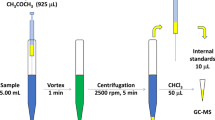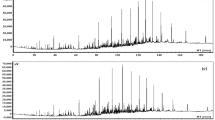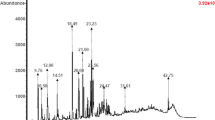Abstract
Some of the most common spills in waterways involve petroleum products, which are complex mixtures of varying compositions, depending on source and refining procedures. The tendency for components of potential toxicological significance to distribute to the aqueous phase under spill conditions needs to be determined. This paper is devoted to the chemical analysis of the water-soluble fractions (WSF) of gasoline, kerosene, and No. 2 fuel oil, which were added to drinking water and extracted into the aqueous phase under simulated field conditions. Initial aspects of the study dealt with the identification and distribution of the major components to the aqueous phase using pentane extraction and capillary column gas chromatography/mass spectrometry (GC/MS) for analyses. Results show that at least 95% by weight of the components in the WSF of each fuel sample were aromatic compounds having 6 to 13 carbons.
Similar content being viewed by others
References
Anderson JW, Neff JM, Cox BA, Tatem HE, Hightower GM (1974) Characteristics of dispersions and water-soluble ex tracts of crude and refined oils and their toxicity to estuarine crustaceans and fish. Mar Biol 27:75–88
Bingham E, Trosset R, Warshawsky D (1980) Carcinogenic po tential of petroleum hydrocarbons: A critical review of the literature. J Environ Pathol Toxicol 3:483–563
Blumer M, Hunt JM, Atema J, Stein L (1973) Interaction be tween marine organisms and oil pollution. EPA Ecological Research Series R3-73-042. Order No. PB-222 628/OBE National Technical Information Service, Springfield, VA 22161
Boehm PD, Fiest DL, Mackay D, Paterson S (1982) Physicalchemical weathering of petroleum hydrocarbons from the Ixtoc I blowout: Chemical measurements and a weathering model. Environ Sci Technol 16:498–505
Brooks JM, Wiesenburg DA, Burke RA, Jr, Kennicutt MC (1981) Gaseous and volatile hydrocarbon inputs from a subsurface oil spill in the Gulf of Mexico. Environ Sci Technol 15:951–959
Coleman WE, Melton RG, Slater RW, Kopfler FC, Voto SJ, Allen WK, Aurand TA (1981) Determination of organic contaminants by the Grob closed-loop-stripping technique. J Am Water Works Assoc 73:119–125
Dauble DD, Fallon WE, Gray RH, Bean RM (1982) Effects of coal liquid water-soluble fractions on growth and survival of four aquatic organisms. Arch Environ Contam Toxicol 11:553–560
Giddings JM, Washington JN (1981) Coal liquefaction products, shale oil, and petroleum. Acute toxicity to freshwater algae. Environ Sci Technol 15:106–108
Grob K, Grob G, (1979) Practical capillary gas chromatography—A systematic approach. J High Resolut Chromatogr Commun 2:109–117
Gschwend PM, Zafiriou OC, Mantoura RFC, Schwarzenbach RP, Gagosian RB, (1982) Volatile organic compounds at a coastal site. 1. Seasonal variations. Environ Sci Technol 16:31–38
Guerin MR, Ho C-h, Rao TK, Clark BR, Epier JL (1980) Polycyclic aromatic primary amines as determinant chemical mutagens in petroleum substitutes. Environ Res 23:42–53
Montz WE, Jr, Puyear RL, Brammer JD, (1982) Identification and quantification of water-soluble hydrocarbons generated by two-cycle outboard motors. Arch Environ Contam Toxicol 11:561–565
Reinhard M, Drevenkar V, Giger W, (1976) Effect of aqueous chlorination on the aromatic fraction of diesel fuel: Analysis by computer-assisted gas chromatography-mass spectrometry. J Chromatogr 116:43–51
Whittemore IM, (1979) High resolution gas chromatography of the gasolines and naphthas. In: Altgelt KH, Gauw TH, (eds) Chromatography in petroleum analysis. Marcel Dekker, New York pp. 41–74
Zürcher F, Thüer M, (1978) Rapid weathering processes of fuel oil in natural waters: Analyses and interpretations. Environ Sci Technol 12:838–843
Author information
Authors and Affiliations
Rights and permissions
About this article
Cite this article
Coleman, W.E., Munch, J.W., Streicher, R.P. et al. The identification and measurement of components in gasoline, kerosene, and no. 2 fuel oil that partition into the aqueous phase after mixing. Arch. Environ. Contam. Toxicol. 13, 171–178 (1984). https://doi.org/10.1007/BF01055874
Received:
Revised:
Issue Date:
DOI: https://doi.org/10.1007/BF01055874




